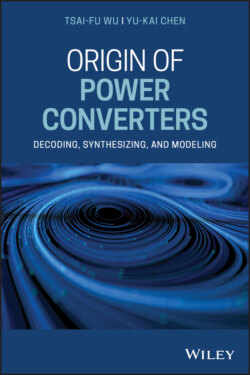Читать книгу Origin of Power Converters - Tsai-Fu Wu - Страница 36
2.3 Duality
ОглавлениеIn mathematical optimization theory, duality means that optimization problems may be viewed from either of two perspectives, the primal problem or the dual problem. Similarly, in circuit theory, duality means that viewing from either of the two variables, voltage and current, can yield the same output expression for the two dual circuits. Typical examples of two RLC networks are shown in Figure 2.8, in which the series RLC network is driven by a voltage source, while the parallel RLC network is driven by a current source. The circuits shown in Figure 2.8a and b are dual. It can be observed that when replacing the voltage source with a current source and the components in series with the ones in parallel, we can obtain a dual circuit of the other and we can determine the branch currents in parallel from the voltages across the branches in series. The dual networks shown in Figure 2.8 have one‐to‐one correspondence.
Conventionally, with the duality theory, the boost converter can be derived from the buck converter. The buck converter is first represented in the form shown in Figure 2.9a, in which the output inductor–capacitor filter is simplified to a current sink. Then, replacing the voltage source Vi with a current one Ii, the switch S1 in series with a parallel one, the diode D1 in parallel with a series one, and the output current sink Io with a voltage sink Vo can yield the boost converter shown in Figure 2.9b. They have one‐to‐one correspondence. Since the converters are represented in voltage/current sources and voltage/current sinks, they are called topologically dual converters. When comparing the topological converters with the component converters shown in Figure 2.10, one can reveal that they do not have one‐to‐one correspondence and, in fact, they are not dual converters. In Figure 2.10a, capacitor C1 realizes the voltage source Vi, while in Figure 2.10b, capacitor C1 and inductor L1 together realize the current source Ii. Similarly, the output current sink Io is realized with capacitor C2 and inductor L1 in Figure 2.10a. In the buck and boost converters, the voltage source or sink is realized with a single capacitor. Why is a current source or sink realized with a capacitor and an inductor rather than a single inductor? Is it because there is no current source or sink, or even the configurations of the buck and boost converters are incorrect? The answers to these questions will be left for later discussions in Chapter 11.
Figure 2.8 Dual RLC networks (a) in series and driven by a voltage source and (b) in parallel and driven by a current source.
Figure 2.9 Topologically dual converters: (a) buck and (b) boost.
Figure 2.10 Component realization of (a) buck and (b) boost converters.
Evolution of power converters from the buck converter, the original converter, is based on a converter level, and it requires having the desired voltage transfer code decoded in terms of the transfer codes of the fundamental converters. How to manipulate the converters from the decoded or factorized transfer codes requires using some fundamental circuit theories and principles. They will be addressed in Chapter 3.
